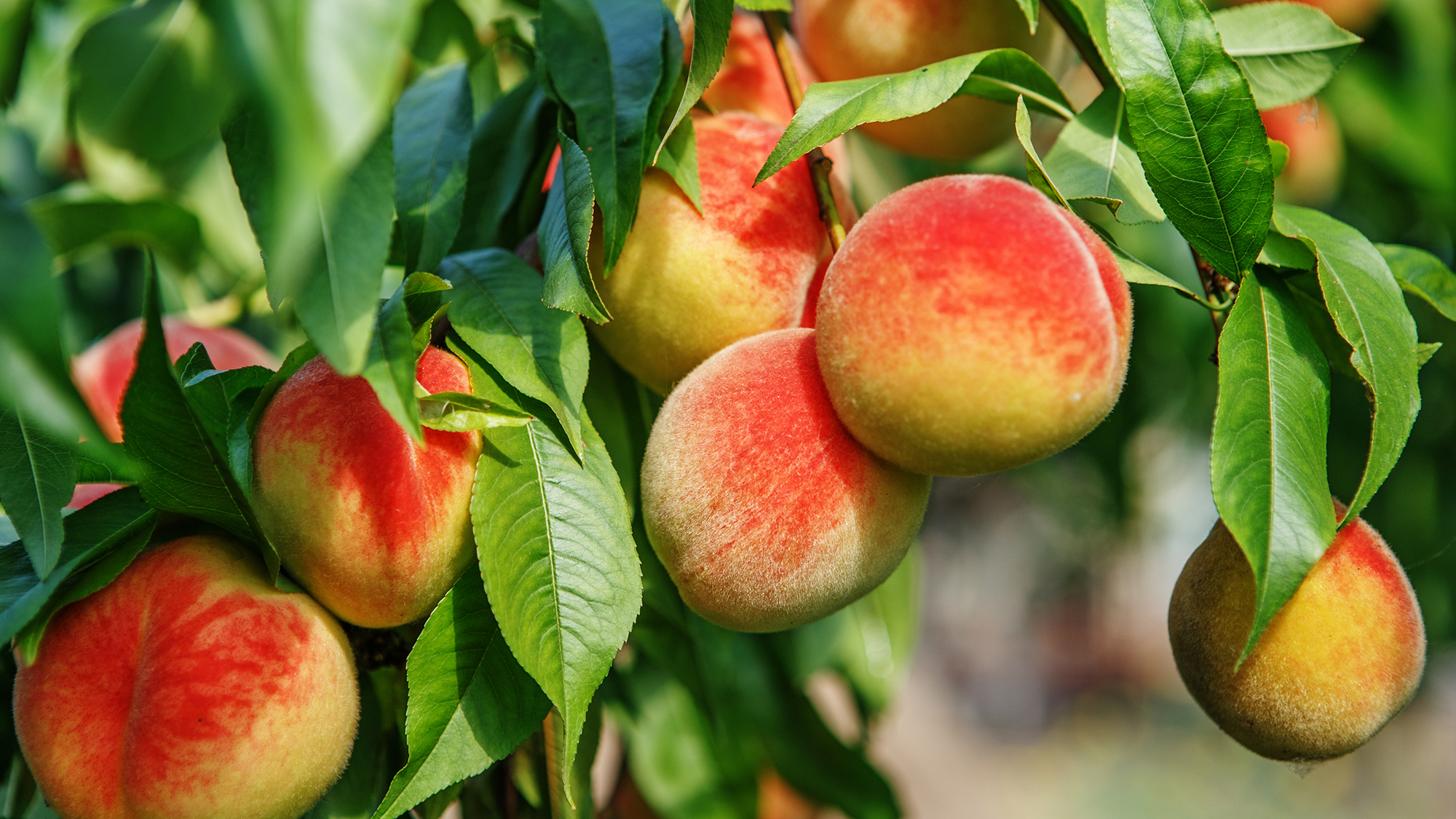How to grow a peach tree from seed – for delicious fruit
Hugely rewarding, learning how to grow a peach tree from seed is surprisingly easy …. all you need is patience


Whether you adore the juicy fruit, fancy growing a good-looking tree for your yard or just a satisfying foody project, discovering how to grow a peach tree from seed is fascinating. It’s mesmerizing to see how a hard, wrinkled pit, found at the center of this delicious fruit can germinate and turn into a fully grown tree in just a few years.
Yes, it will take three years or more until it produces fruit but it’s hugely gratifying to witness, plus it will cost you next to nothing to grow one of the best fruit trees for backyards.
While commercial plant nurseries will graft a particular peach variety onto a reliable rootstock, to determine the characteristics of the resulting tree, growing a peach tree from seed is a much more variable approach. Thanks to the way these trees reproduce, the plant will inherit both female and male traits and this can vary the productivity, flavor, crop and even mature size of the full-grown tree.
There is no way to determine the outcome so embrace it as part of the project. After all, you may end up with a hugely delicious and abundant crop. So, tempted to grow your own peach tree from seed? Our expert guide has all the info you need to know.
How to grow a peach tree from seed

Below, we cover everything from how to find the perfect peach tree seed to plant to how to plant fruit trees of this kind. The result? A fruit bowl full of juicy peaches.
Choosing the perfect peach pit
Deciding which peach to grow is not just down to flavor but also finding the perfect candidate. Sowing the stone (or pit) from a commercial and widely available variety is the most reliable option, as they tend to be vigorous growers and pretty resistant to disease. Choose from eating and canning varieties but do avoid hybrids as due to their breeding these will not germinate.
There are hundreds of different peach types to choose from and it’s worth researching which grow well in your area. Many will be happy overwintering in temperatures down to -10℉ (-23℃) and there are few that will tolerate -20℉ (-29℃).
Design expertise in your inbox – from inspiring decorating ideas and beautiful celebrity homes to practical gardening advice and shopping round-ups.
How to get a peach pit to germinate
Remove the pit from the fruit. Wash off any juicy remnants and leave to dry for a couple of weeks. To encourage germination, plant the seed during the fall or winter, a few weeks before the final frosts. This spell of cold weather will shock the dormant shoot into growth. To aid the shoot in breaking through the pit’s hard outer casing rub it gently with sandpaper, just be careful not to harm the kernel inside.
After a couple of weeks drying, place the pit in a pot that’s at least 12 inches deep (30cm) filled with seed compost. This will allow plenty of room for the tap root to grow. Push the pit 1in (2.5cm) deep into the soil, keep moist and place somewhere warm. It can take up to six weeks for the first leaves to appear.
Gradually acclimatizing a new peach tree to outside temperatures is key to steady, healthy growth. Wait until after the frosts have passed and move the plant outside for a couple of hours. Repeat each day, increasing the amount of time by an hour each time until the plant is fully used to the outdoor conditions.
How to plant a young peach tree
Peach trees love full sun. Choose a sheltered spot to plant a peach tree, well out of any frost pockets as peach trees are early flowerers and are prone to frost damage.
Free-draining soil is also a must, as they hate for their roots to sit in water. Aim for a loamy, sandy topsoil of around 6.5-7pH. If you are faced with a heavier, clay soil you will need to work in some compost and grit to improve nutrients and drainage. It is often advised to plant them on a slight mound to aid drainage.
Dig a hole large enough to accommodate the root ball, ensuring that the top of the root ball is level with the surrounding soil. Providing the plant is well watered, particularly throughout the growing season, it should grow vigorously.
Growing a peach tree in a pot
Peach trees are ideal for container garden ideas, as long as the planter is large enough. The experts at Stark Bro's Nurseries say, ‘Most people choose to grow fruit trees in containers for easy mobility. For this purpose, the ideal container size is about 10-15 gallons – substantial enough to support a tree, but small enough to move easily. It also comes in handy if you need to relocate your tree to an unheated garage, shed, or basement during winter.’
Good drainage is key for growing peach trees, so ensure the container has plenty of large drainage holes and add a base layer of stones or grit before topping up with compost. Raising the container up on pot feet will also encourage water to drain freely.
Guy Barter, Chief Horticulturalist of the RHS suggests to ‘water container-grown trees almost every day during the growing season and give them a high potassium liquid feed every couple of weeks.’ He also adds to ‘repot compact peaches in containers every couple of years, using loam-based potting compost.’
How to care for a peach tree
Pruning a peach tree is essential if you want it to remain healthy and produce an ample crop. ‘For stone fruits – cherries, plums, peaches, nectarines and apricots – pruning should be left until the sap starts to rise (usually around mid March),’ says Jon Munday, of Blackmoor Nurseries.
Aim to create an open vase or goblet shape by removing central stems and encouraging plenty of air flow. There are plenty of detailed expert guides on pruning fruit trees but as the team at Stark Bros say, ‘many people think the task overwhelming or too complicated. It doesn’t have to be! Have confidence in knowing that not everyone will prune the exact same way – including the experts.’
Peach trees, like most fruit trees benefit from extra nitrogen and potassium to ensure strong bud formation and a healthy crop. Sprinkle a granular balanced fertilizer around the base of the tree in early spring.
Do peach trees suffer from pests and diseases?
There are a few threats peach trees have to deal with. The main one is a fungal condition that effects the foliage. ‘Control of peach leaf curl is essential. Peach leaf curl is a fungal disease, which, if left untreated, puts trees under severe stress due to the excessive leaf loss,’ says Jon Munday of Nursery Manager at Blackmoor.
The easiest way to prevent this condition is to protect the plant from rain and frost during the cooler months – late fall through to mid spring. Cover the plant with a rigid rain shelter covered with plastic sheeting. If white spores do appear on any leaves, pick them off immediately and burn or dispose of them with household garbage.
Squirrels love feasting on the fresh buds of peach trees but are tricky to deter. One simple trick is to remove tree branches that hang near boundaries and other overhanging trees and shrubs to make your peach tree more difficult to reach. Another is to fit a metal tree collar at the top of the trunk, just before the branches emerge.
Brown scale are sap sucking bugs that feed off the plant and gradually lead to leaf loss and sickly plants. Encouraging natural predators such as ladybugs, birds and parasitoid wasps is a great way to control infestations without resorting to chemicals.

Journalist Jill Morgan has spent over 20 years writing and editing gardening, interior and property features. Titles she has worked on include The English Home, House Beautiful, Ideal Home, Houzz and Modern Gardens and she writes regularly for H&G as a Contributing Editor. Whilst she is a dab hand at renovation projects and DIY, she is happiest when out digging in the garden or planning a new border.